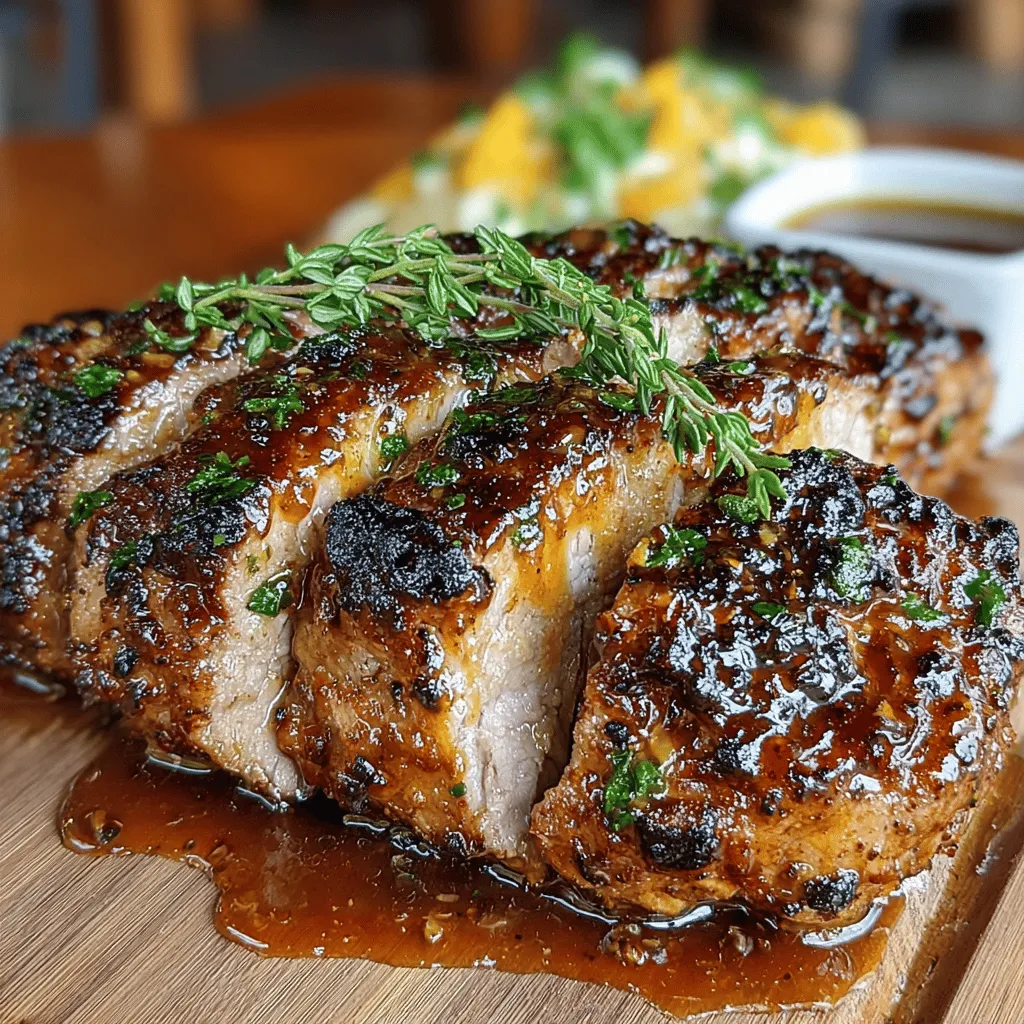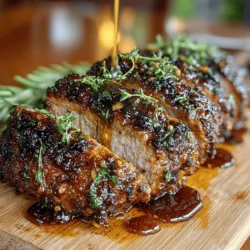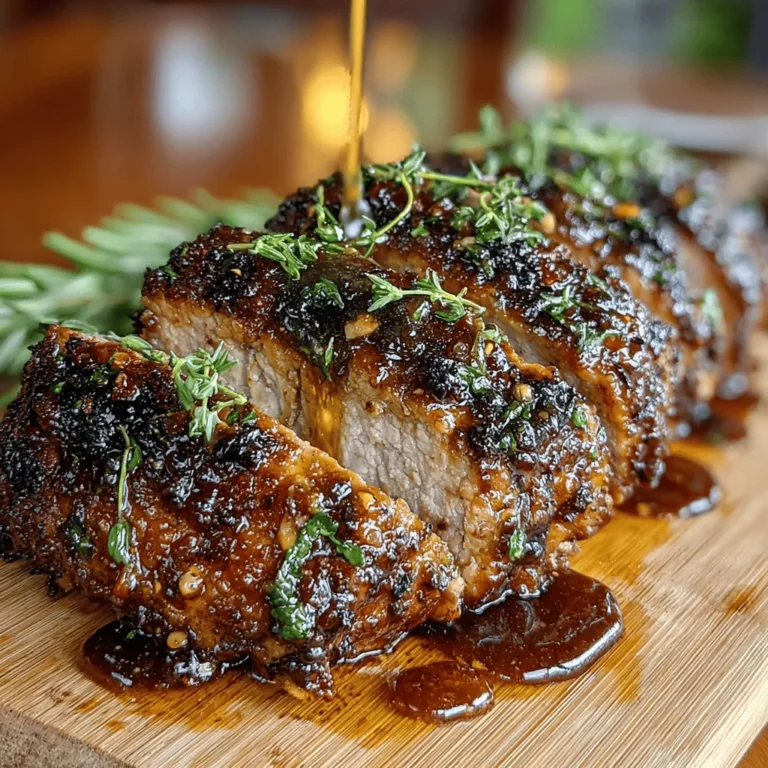Sweet & Savory Honey Mustard Glazed Pork Tenderloin: An Introduction
If you’re looking for a dish that elegantly combines sweet and savory flavors, look no further than honey mustard glazed pork tenderloin. This recipe encapsulates the essence of culinary balance, offering a delightful experience for the palate. The succulent pork tenderloin is enveloped in a luscious glaze that marries the natural sweetness of honey with the zesty bite of Dijon mustard, creating a dish that is both comforting and refined. Whether you’re hosting a special gathering or simply preparing a weeknight dinner for your family, this dish is versatile enough to shine on any occasion.
The allure of honey mustard glazed pork tenderloin lies not only in its flavor profile but also in its simplicity. With just a handful of ingredients, you can create a meal that looks and tastes like it took hours to prepare. This dish is perfect for impressing guests without overwhelming yourself in the kitchen. The glaze caramelizes beautifully in the oven, resulting in a comforting, golden-brown exterior that beckons to be savored.
Understanding Pork Tenderloin
Before diving into the recipe, it’s essential to understand what makes pork tenderloin such a popular choice for this dish. The pork tenderloin is a long, thin cut of meat that comes from the muscle along the backbone of the pig. Known for its tenderness and mild flavor, it stands out among other cuts of pork for its lean profile. Unlike fattier cuts, such as pork belly or shoulder, the tenderloin is easy to cook and lends itself well to a variety of preparations, making it a staple in many kitchens.
In addition to its delightful texture, pork tenderloin offers a range of nutritional benefits. It is rich in protein, which is essential for muscle repair and overall health. Furthermore, it contains significant amounts of B vitamins, particularly B6 and B12, which play vital roles in energy metabolism and maintaining a healthy nervous system. Compared to other pork cuts, tenderloin is lower in calories and fat, making it an excellent choice for health-conscious diners.
Key Ingredients for the Glaze
The magic of honey mustard glazed pork tenderloin lies in its glaze, which consists of a few key ingredients: honey, Dijon mustard, and apple cider vinegar. Each element plays a crucial role in creating a harmonious balance of flavors.
Honey serves as the primary sweetener in the glaze, contributing not only sweetness but also promoting caramelization during cooking. This natural sweetener enhances the dish’s overall appeal, giving it a beautiful, glossy finish that is as visually enticing as it is delicious. The caramelization process adds depth to the flavor, creating a sweet crust that contrasts beautifully with the savory meat.
Dijon mustard, on the other hand, introduces a tangy complexity to the glaze. Its sharpness cuts through the sweetness of the honey, providing a perfect balance that elevates the dish. The unique flavor profile of Dijon mustard, with its blend of spices and vinegar, adds a layer of sophistication that transforms a simple pork dish into a gourmet experience.
To round out the glaze, apple cider vinegar adds a touch of acidity. This ingredient is essential for balancing the sweetness of the honey and the tang of the mustard. The acidity helps to brighten the overall flavor, ensuring that no single element overpowers the others. Together, these three ingredients create a dynamic glaze that enhances the natural flavors of the pork tenderloin.
In addition to the primary ingredients, several additional components contribute to the dish’s depth of flavor. Garlic, for instance, adds a robust aroma and savory notes that complement the sweetness of the honey. Not only does garlic enhance the overall taste, but it also brings health benefits, such as anti-inflammatory properties and immune system support.
Thyme is another key ingredient that adds an aromatic quality to the glaze. This herb is known for its earthy flavor, which pairs exceptionally well with pork. Thyme also boasts numerous health benefits, including antioxidant properties and potential digestive support, making it a welcome addition to this dish.
Lastly, smoked paprika introduces a unique flavor profile that enhances the overall dish. The mild smokiness of paprika adds depth and complexity, creating a multifaceted glaze that is anything but ordinary. This ingredient not only enhances the flavor but also contributes to the visual appeal, providing a vibrant color that makes the dish pop.
Preparation Steps Explained
Now that we’ve explored the ingredients that make this dish so special, let’s break down the preparation process step-by-step.
1. Preheat the Oven: Start by preheating your oven to 400°F (200°C). This temperature will ensure that the pork tenderloin cooks evenly while allowing the glaze to caramelize beautifully.
2. Prepare the Pork Tenderloin: Begin by patting the pork tenderloin dry with paper towels. This step is crucial for achieving a nice sear and ensuring the glaze adheres properly. Trim any excess fat or silver skin from the tenderloin, as these can affect the texture and flavor of the final dish.
3. Make the Glaze: In a medium-sized bowl, whisk together the honey, Dijon mustard, apple cider vinegar, minced garlic, thyme, and smoked paprika. Keep whisking until the ingredients are well combined, forming a smooth glaze. The aroma of the mixture will be enticing, hinting at the deliciousness to come.
4. Season the Pork: Generously season the pork tenderloin with salt and pepper. This step enhances the meat’s natural flavors and sets the stage for the glaze to shine.
5. Sear the Meat: In an oven-safe skillet, heat a drizzle of olive oil over medium-high heat. Once the oil is hot, add the pork tenderloin to the pan. Sear each side for about 2-3 minutes until golden brown. This step not only adds flavor but also creates a beautiful crust that locks in moisture.
6. Apply the Glaze: After searing, remove the skillet from heat. Brush a generous amount of the honey mustard glaze over the pork tenderloin, ensuring it’s evenly coated. Reserve some glaze for basting later in the cooking process.
7. Roast in the Oven: Place the skillet in the preheated oven and roast the pork tenderloin for about 20-25 minutes, or until it reaches an internal temperature of 145°F (63°C). Baste the pork with the reserved glaze halfway through the cooking time to enhance the flavor and ensure a glossy finish.
As you follow these steps, the sweet and savory aromas of the honey mustard glaze will fill your kitchen, enticing everyone nearby. This dish is not only a feast for the taste buds but also a visual delight, making it a perfect centerpiece for any meal. The combination of tender, juicy pork and a beautifully caramelized glaze is sure to impress all who partake.

Importance of Marinating the Pork
Marinating pork tenderloin is a crucial step that enhances the flavor profile of the dish. The honey mustard marinade not only infuses the meat with a blend of sweet and tangy flavors but also tenderizes the pork, making it more succulent. Ideally, marinate your pork for at least 30 minutes, but for optimal flavor, aim for 2 to 4 hours. If time allows, marinating overnight in the refrigerator can take the taste to an entirely new level. The acids in the marinade (from the mustard and vinegar) break down the tough muscle fibers, resulting in a fork-tender texture once cooked.
The Technique of Searing
Searing the pork tenderloin serves multiple purposes. This cooking technique involves cooking the meat in a hot pan with a bit of oil, creating a golden-brown crust that enhances flavor through the Maillard reaction. This crust not only adds a depth of flavor but also helps to lock in moisture, ensuring that the pork remains juicy and tender. To achieve a perfect sear, heat your oven-safe skillet over medium-high heat until it is hot but not smoking. Add a tablespoon of oil, then place the marinated pork tenderloin in the skillet. Avoid overcrowding the pan, as this can cause the meat to steam rather than sear.
Explanation of Resting the Meat
Resting the pork after cooking is essential for achieving maximum juiciness. When meat cooks, the muscle fibers contract, pushing juices toward the center. If you cut into the meat immediately after cooking, those juices will escape, leaving you with dry pork. Allow the tenderloin to rest for at least 5 to 10 minutes before slicing. This resting period lets the juices redistribute throughout the meat, ensuring that every bite is full of flavor and moisture.
Visual Cues to Watch For
Throughout the cooking process, pay attention to visual cues that indicate how well your pork is cooking. During marination, the pork will take on a glossy appearance from the glaze. While searing, look for a deep golden-brown color on the exterior—this indicates a good crust has formed. As the pork roasts in the oven, you should see the meat change from a raw pink to a light white color. Use a meat thermometer to check for doneness: the internal temperature should reach 145°F (63°C). This ensures that the pork is safe to eat while remaining moist and tender.
Cooking Techniques for Perfect Pork Tenderloin
Importance of Using an Oven-Safe Skillet
Using an oven-safe skillet for both searing and roasting the pork tenderloin is highly beneficial. This technique allows you to transition from stovetop to oven without needing to transfer the meat to another dish, which can disrupt the cooking process and cause loss of juices. A cast-iron skillet or a heavy-bottomed pan works best for this method, as they retain heat well and promote even cooking.
Explanation of Temperature Control
Temperature control is key when cooking pork tenderloin. Start with a preheated oven set to 400°F (204°C) to ensure a quick roast that locks in the flavors. Keep a close eye on the temperature throughout the cooking process; if the oven temperature is too high, the outside of the pork may cook too quickly, leaving the inside undercooked. Conversely, a low temperature will dry out the meat.
Monitoring Internal Temperature
Using a meat thermometer is the best way to ensure perfect doneness. Insert the thermometer into the thickest part of the tenderloin without touching any bone. The pork is perfectly cooked when it reaches 145°F (63°C). Once you remove it from the oven, remember to let it rest; the internal temperature will rise slightly as it sits, ensuring the meat remains juicy.
Tips for Brushing Glaze
To enhance the flavor of your pork tenderloin, brush the honey mustard glaze onto the meat halfway through the roasting process. This not only adds a beautiful shine but also creates a sticky, caramelized exterior. Make sure to reserve some glaze for serving. This method intensifies the flavor, creating a delightful contrast between the sweet glaze and the savory pork.
Serving Suggestions
When it comes to serving your Honey Mustard Glazed Pork Tenderloin, consider pairing it with complementary side dishes that can round out the meal beautifully. Here are a few ideas:
– Roasted Vegetables: Seasonal vegetables such as carrots, Brussels sprouts, and sweet potatoes can be roasted alongside the pork for a nutritious and colorful plate.
– Mashed Potatoes: Creamy mashed potatoes are a classic side that pairs perfectly with the tangy glaze of the pork. For an extra flavor boost, consider adding garlic or herbs to your mash.
– Fresh Salads: A light salad with mixed greens, nuts, and a vinaigrette can provide a refreshing counterbalance to the richness of the pork.
Presentation Tips
To create an appealing serving platter, slice the rested pork tenderloin into medallions and arrange them attractively on a large platter. Drizzle any remaining honey mustard glaze over the slices for a glossy finish. Consider adding sprigs of fresh thyme or parsley around the edges of the platter for a pop of color and a hint of herbal aroma.
Storing and Reheating Leftovers
Best Practices for Storing Leftovers
If you find yourself with leftover pork tenderloin, proper storage is key to maintaining its flavor and texture. Allow the meat to cool completely before wrapping it tightly in plastic wrap or aluminum foil. You can also store it in an airtight container. Refrigerate the leftovers for up to 3 to 4 days. For longer storage, consider freezing the pork, which can extend its shelf life to about 3 months.
Tips for Reheating
When reheating pork tenderloin, it’s essential to do so gently to avoid drying it out. The best method is to reheat it in the oven. Preheat your oven to 325°F (163°C) and place the pork in a baking dish with a splash of broth or water to maintain moisture. Cover the dish with foil to prevent excessive browning. Heat for about 15-20 minutes or until warmed through. Alternatively, you can use a microwave, but be sure to do so in short increments, checking frequently to avoid overcooking.
Creative Ideas for Using Leftovers
Leftover pork tenderloin can be incredibly versatile. Here are a few ideas on how to incorporate it into other meals:
– Sandwiches: Slice the pork thinly and layer it with your favorite toppings on a crusty roll for a satisfying sandwich. Add some arugula, pickles, or a drizzle of extra honey mustard for extra flavor.
– Salads: Chop the leftover pork and toss it into a fresh salad for added protein. Combine with mixed greens, cherry tomatoes, and a light vinaigrette for a quick and healthy meal.
– Stir-Fries: Cut the pork into bite-sized pieces and sauté it with vegetables and a savory sauce for a quick stir-fry. This is a great way to use up any leftover veggies in your fridge.
Conclusion
The Sweet & Savory Honey Mustard Glazed Pork Tenderloin is a delightful dish that showcases a wonderful balance of flavors. The sweetness of honey combined with the tanginess of mustard creates a glaze that elevates the tender pork to new heights. Whether you’re cooking for a special occasion or simply looking for a delicious meal to enjoy at home, this recipe is sure to impress.
With easy preparation techniques and satisfying results, you’ll find this dish quickly becomes a favorite in your repertoire. Don’t hesitate to try this recipe for your next family dinner or gathering; the flavors and presentation will leave your guests raving about your culinary skills. Embrace the joy of cooking at home, and enjoy the satisfaction that comes with serving a dish that’s not only delicious but also packed with love.


